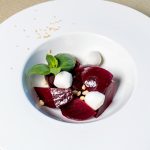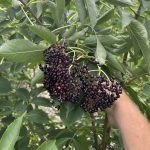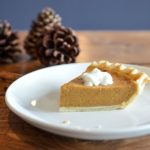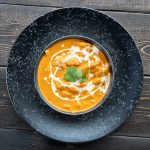Get The Most Out of Your Lavender from Backyard Eats
Harvesting Lavender
When It’s Ready
- Lavender is ready when the plant begins to send up flower spikes
- Flowers can be harvested midsummer
- Harvest no more than one-third of a plant at a time to allow continued regrowth
- Harvest at any time of the season
- Mid-June – September
How To
- Cut with scissors or pruners about one-third down the length of a main stem
- Or clip off an entire branch
- Pruning or harvesting midsummer is essential to maintaining a healthy looking plant
- Without pruning, lavender will form a woody and leafless center
About Mediterranean Herbs
Mediterranean herbs are plants that grow 0.5-3 ft tall. They require partial to full sun to thrive, but not trellising or pruning.
Flowering/Fruiting Tendencies
Mediterranean herbs are easy, multi-harvest plants for fresh use, drying, teas, and medicines. Most are typically easy to establish and just need seasonal clean-ups.
Design Notes
Space herbs about 18″ apart. Most are Mediterranean herbs don’t do well in super cold or moist soil. Will overwinter better in warm conditions.
Care Notes
Kitchen herbs benefit from compost. Mulching can be kept to a minimum as many kitchen herbs won’t benefit from the extra moisture retention. Kitchen herbs can typically be thinned/harvested in the summer and fall to keep them from growing wild. Many will get unwieldy and less productive after a few years and may need to be replaced.
Newly planted perennials require some additional care to help establish and support the plants as they grow. Water newly planted perennials deeply at the root 2-3 times a week during the first growing season. Apply compost and wood chip mulch in the late winter/early spring.
Storing Lavender
Long-Term Storage: “Woody” perennial herbs like lavender can be dried at home to enjoy all year long! First, trim stems from the main plant. Tie 3-5 stems together into a bundle, then hang them to dry in a cool, dark, and well-ventilated place for 2-3 weeks.
Once the herbs are dry and brittle, you can store and enjoy them long-term.

Cooking With Lavender
- Lavender Lemonade: Infuse lavender flowers in lemonade for a fragrant and refreshing drink. Simply steep dried or fresh lavender flowers in hot water, strain, and mix the lavender-infused water with lemon juice and sweetener to taste.
- Lavender Shortbread Cookies: Add dried culinary lavender buds to a classic shortbread cookie recipe for a delicate floral twist. The lavender adds a subtle aroma and flavor to the buttery cookies.
- Lavender-Infused Honey: Combine dried or fresh lavender flowers with honey in a jar and let it infuse for several days. The floral notes of lavender beautifully complement the sweetness of the honey, making it a delightful addition to tea, yogurt, or as a drizzle over desserts.
- Lavender Roasted Chicken: Rub chicken with a mixture of dried lavender buds, salt, pepper, and olive oil before roasting. The lavender adds a unique and fragrant dimension to the savory flavors of the chicken.
- Lavender Simple Syrup: Make a lavender-infused simple syrup by simmering equal parts water and sugar with dried lavender flowers. Use this syrup to sweeten cocktails, iced tea, or as a flavoring for desserts like cakes or sorbets.




